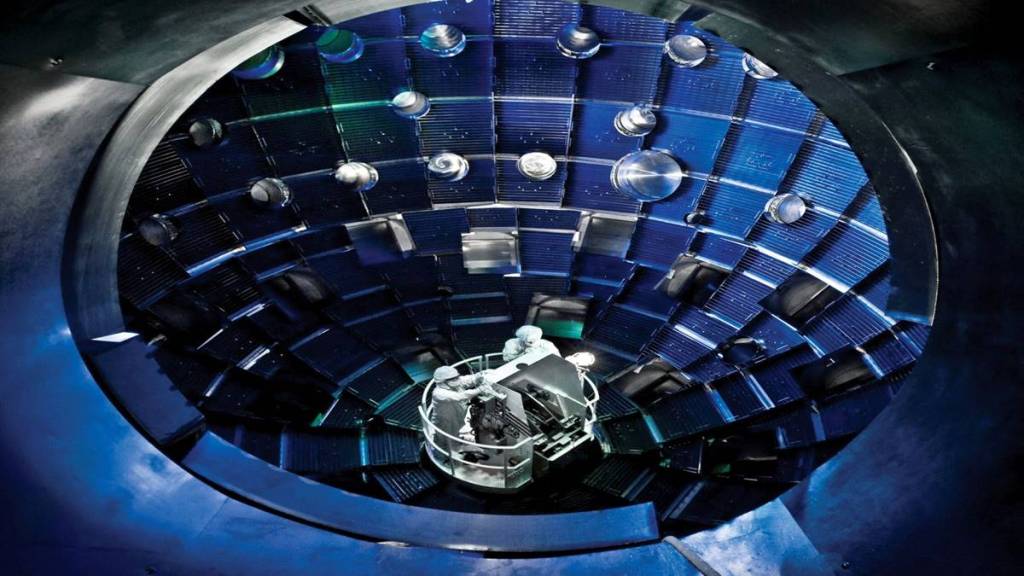Nuclear fusion is viewed as a potential source of boundless, clean energy. Thus, the recent news of net energy gain (more energy produced by the fusion reaction than used in precipitating it) for the first time ever has fuelled excitement across the world. Sarthak Ray takes a look at what prospects the development holds for energy security.
Nuclear fusion, and its energy potential
Nuclear fusion occurs when two or more atomic nuclei—comprising protons and neutrons—combine to form new types of atomic nuclei. The Sun and other stars are powered by fusion; here, an astronomical quanta of force compresses and heats hydrogen plasma, and causes its isotopes to fuse and form helium, releasing massive amounts of energy.
Scientists at the National Ignition Facility (NIF), Lawrence Livermore National Laboratory (LLNL), the US, recently announced that they had achieved ‘net energy gain’ from fusion—that is, produced more energy from a fusion experiment than the experiment had consumed (3.15 megajoules versus 2.05 MJ). So far, fusion experiments have used more energy or just broken even.
The National Ignition Facility experiment explained…
For 70 years now, scientists have been experimenting with fusion with many goals, including energy security, in mind.
The NIF researchers used a mixture of deuterium and tritium—two variants of hydrogen. While the nucleus of ‘regular’ hydrogen has one proton and no neutrons, deuterium has one proton and one neutron, and tritium has one proton and two neutrons. In a fusion reaction, deuterium and tritium combine to form a helium nucleus (two protons and two neutrons) and one neutron, with the release of energy.
The NIF experiment bombarded a tiny pellet of deuterium and tritium with light from 192 lasers, in a process called inertial confinement fusion, and achieved the collision of some nuclei that fused and formed helium nuclei and released energy.
Energy equation
Nuclei, carrying similar charges (positive, from the protons), repel each other. Fusion needs a lot of energy to overcome the Coulomb barrier or the threshold beyond which nuclear repulsion yields to attraction. Because hydrogen has just one proton, it needs the lowest quantum of such energy; hence, its ubiquity in fusion. Fusion ignition occurs when a reaction produces more energy than it uses and becomes self-sustaining.
Chasing fusion
Fusion can theoretically guarantee energy security and is cleaner and safer than fission, where a nucleus is split to release energy. It produces 3-4X more energy than fission and, unlike the latter, doesn’t carry the risk of runaway reactions and the problem of radioactive waste (safe disposal and weaponisation). Also, deuterium is abundant in sea water, and tritium can be harvested from lithium irradiation; lithium is scarce on land, but the seas hold 230 billion tonnes, as per Japanese scientists.
The fusion landscape today, and where we stand after NIF’s net energy gain…
Fusion projects from Germany, the UK, and China have announced many advances in recent years. Apart from the LLNL facility in the US, France has its ongoing effort in the International Thermonuclear Experimental Reactor (ITER). The Fusion Industry Association’s 2022 report lists 33 private companies that sent in responses for the report. The funding received by these companies stands at $4.8 billion, having grown almost 1.7 times from 2021 levels.
While the NIF ‘net energy gain’ is, without doubt, a step forward, truly benefiting from fusion energy seems very distant as of now because of a clutch of factors.
First, the cost. To illustrate, the ITER facility is estimated to cost anywhere between $22 billion (by its management) and $65 billion (by the US department of energy). Second, the large parasitic power drain. Fusion reactors need an immense amount of power to operate. The NIF success (3.15 MJ output vs 2.05 MJ input) took 400 MJ, just to charge the lasers. Add to that the entire facility’s power demand. Third, NIF’s was just one event. To realistically cater to energy demand, it must be repeated, per environmental scientist Peter Gleick, a million times faster, with lasers that are at least 1,000 times more efficient.
—
* 33 fusion energy companies worldwide in 2022 (Source: Fusion industry association)
* 1 kg fusion fuel can theoretically replace 55,000 barrels of oil, 10,000 tonnes of coal (Source: General Fusion)


